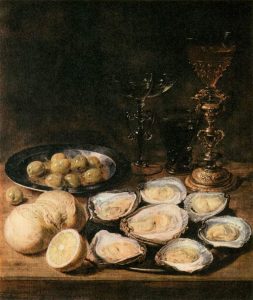Eat Oysters!
Oysters are salt-water bivalve molluscs that live in brackish marine habitats. Shells are highly calcified and irregular in shape. Oysters are consumed cooked or raw and are commonly regarded as a delicacy.
According to John Staughton in “8 Wonderful Benefits of Oysters”, health benefits include the ability of oysters to aid in weight loss, boost metabolic activity, increase tissue repair and growth, lower cholesterol levels, reduce blood pressure, improve immune functions, aid in wound healing, and promote healthy growth. Furthermore, they are known to be a powerful aphrodisiac, and also increase bone strength to reduce osteoporosis.
The valves in oysters can actually cleanse the entire ecosystem of pollutants and are a major benefit to the environment.
The shells are made of 98% pure calcium carbonate, containing about 35% calcium. The carbonate comes from the carbon dioxide in the environment. (Bingo!)
I am told that oysters and absinthe are a match made in heaven. “The combination of briny, mineral-rich oysters and the soft fennel and mint of the absinthe strikes a chord with the American palate” says Ben Crispin, the maître d’ of a fancy Brooklyn restaurant called Maison Premiere



But how?
Ok, I get that living oysters in their briny beds are good for the environnent, but how are they good for the environment if we eat them?
Just curious.
how are they good for the environment
It’s not the oysters, it’s their shells.
The shells are made of 98% pure calcium carbonate, containing about 35% calcium. The rest is carbonate which comes from the carbon dioxide and oxygen in the air.
So, the shells sequester and lock up CO2.
Any kind of seashells would do as well, but oysters have particularly bulky shells.
The shells can be ground up and used instead of sand or gravel in construction.
The material we call limestone is just ancient seashells.
BTW, Ground oyster shells are traditionally preferred for Bocce courts. Molto bene!
Chemistry
Calcium Carbonate (CaCO3) = An atom of Calcium + a molecule of CO2 + an extra atom of Oxygen.
I don’t know where the oysters get their calcium, but THEY do, and that’s what counts.
where the oysters get their calcium
They drink milk every day, and sometimes take supplements.